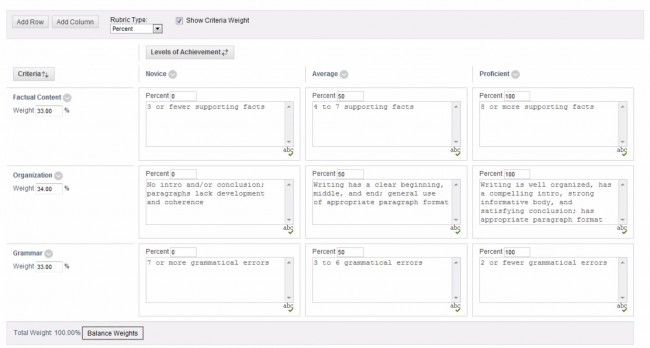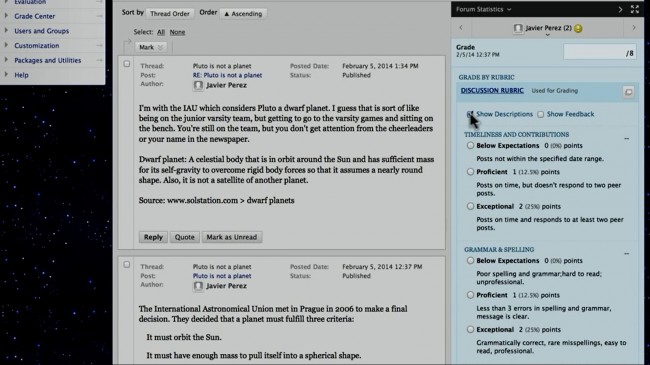Rubrics Now Available in Blackboard
 We’re happy to announce that the Rubrics course tool is now available within Blackboard to instructors. The tool is available by default in new courses. For existing courses, instructors can turn on the tool from the Customization > Tool Availability menu.
We’re happy to announce that the Rubrics course tool is now available within Blackboard to instructors. The tool is available by default in new courses. For existing courses, instructors can turn on the tool from the Customization > Tool Availability menu.
This tool has been requested by many instructors in recent years. Read on for more information about rubrics and how to use them in Blackboard.
What are rubrics?
A rubric is a document that specifies evaluation criteria for a given assignment. Rubrics come in different forms, including holistic and checklist rubrics, but the form used by Blackboard is known as an analytic rubric. Analytic rubrics identify components of the assignment, with each component accompanied by descriptions of levels of quality and each quality level assigned some number of points.
For example, here are the first three rows of a rubric designed to assess a reaction paper in a writing seminar:
| Component | Poor (1 point) |
Acceptable (2 points) |
Good (3 points) |
Excellent (4 points) |
| Response Precision | The article isn’t summarized accurately, nor does the student’s position have much to do with the article’s thesis. | The article isn’t summarized accurately, but there is some alignment between the student’s position and the article’s thesis. | The article is summarized accurately, and the student’s position deals with closely related topics. | The article is summarized accurately, and the student’s position responds precisely to the article’s thesis. |
| Relevance of Argument | The arguments presented by the student for his/her position are mostly weak and/or inappropriate. | The student presents some reasonable arguments for his/her position along with some other weak and/or appropriate arguments. | The arguments the student presents for his/her position are generally appropriate and supports his/her thesis. | The arguments the student presents for his/her position are appropriate, support his/her thesis, and are notably varied or creative. |
| Complexity of Argument | The student fails to consider positions other than the one for which s/he argues in the paper. | The student considers alternate positions or potential objections to his/her arguments, but offers no significant response to those other positions. | The student considers alternate positions or potential objections and offers some responses to those positions. | The student considers several potential objections to his/her arguments and offers appropriate and compelling counter-arguments. |
For an example of a rubric generic enough to use for multiple, different assignments, see the Written Communication VALUE Rubric, a well-constructed rubric for evaluating student writing, developed by a team of faculty experts for the Association of American Colleges & Universities (AAC&U).
For a somewhat more specific rubric, an article in CBE–Life Sciences Education by Deborah Allen and Kimberly Tanner features an analytic rubric for evaluating student posters in a science course.
For an example of a rubric tailored to a particular assignment, see the infographic rubric created by Derek Bruff, director of the Vanderbilt Center for Teaching, and his statistics students. Read Derek’s blog post, “A Crowdsourced Rubric for Evaluating Infographics,” for the collaborative process used to create this rubric.
Why use rubrics?
As detailed descriptions of expectations for student work, rubrics allow instructors to:
- Align their grading with the goals they have for their students’ learning,
- Communicate assignment expectations to their students,
- Be more objective and consistent in their grading across students and courses,
- Provide structured feedback to students when returning assignments, and
- Make grading go a little faster.
For more information on teaching with rubrics, see Chapter 4, “Establishing Criteria and Standards for Grading,” in Effective Grading, 2nd edition, by Barbara Walvoord and Virginia Johnson Anderson (Jossey-Bass, 2009), which provides a comprehensive introduction to rubrics and their value in teaching and learning. See also the Vanderbilt Center for Teaching’s guide to grading student work for strategies and advise on using rubrics.
Instructors can use rubrics outside of Blackboard, but using the Blackboard rubric tool can save time, given its integration with inline grading and the Blackboard grade center.
How do rubrics work in Blackboard?
First, instructors create a generic rubric for use with multiple assignments, or an assignment-specific rubric.
When students submit assignments, instructors can then grade those assignments using a rubric, right within Blackboard via inline grading. Grades and feedback can be shared with students and recorded in the Blackboard grade center.
The blog post “Interactive Rubrics: A Blackboard Tool for Planning and Grading,” by April Lawrence at the College of William & Mary, provides an introduction to Blackboard’s rubric tool, along with a balanced discussion of its uses in teaching.
For step-by-step tutorials, see Blackboard’s video guides, which provided the screenshots above:
- How to Create a Rubric for Grading Student Work [3 minutes, 7 seconds]
- How to Grade Using a Rubric [3 minutes, 23 seconds]



